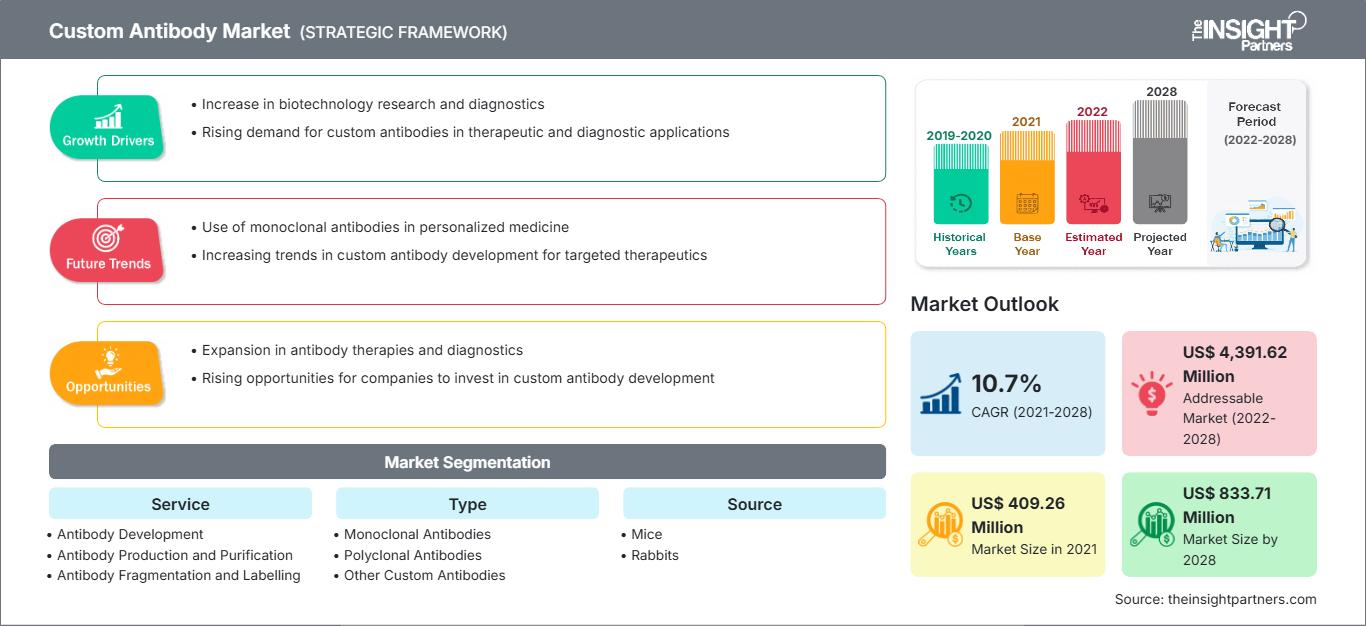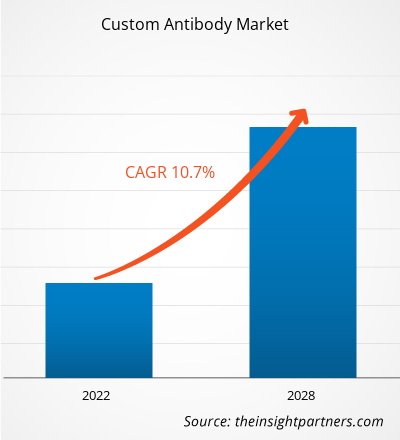El mercado de anticuerpos personalizados se valoró en US$ 833,71 millones en 2028, desde US$ 409,26 millones en 2021; se estima que crecerá a una CAGR del 10,7% entre 2021 y 2028.
Se pueden generar anticuerpos personalizados en ratones, ratas o hámsteres para satisfacer las necesidades de cualquier huésped. Las empresas ofrecen una amplia gama de anticuerpos según las necesidades del investigador. Existe una variedad de anticuerpos personalizados en el mercado, que incluye anticuerpos policlonales y monoclonales, anticuerpos monoclonales recombinantes, anticuerpos de hibridoma, anticuerpos policlonales recombinantes, entre otros. Las empresas ofrecen servicios integrales de soporte para todos los tipos y etapas de la producción de anticuerpos, desde el diseño de péptidos, la síntesis y la conjugación de proteínas transportadoras hasta la inmunización animal, la recolección de suero o la fusión de hibridomas, el análisis de títulos y la purificación final de anticuerpos.
El crecimiento del mercado de anticuerpos personalizados se atribuye a factores como la alta demanda de investigación, el creciente apoyo gubernamental, la constante evolución de los perfiles de enfermedades, el aumento de las colaboraciones público-privadas y el incremento de las actividades de financiación, que están mejorando considerablemente el rendimiento de la biotecnología. Sin embargo, la producción de anticuerpos monoclonales y policlonales varía según los animales utilizados para su obtención. El coste también está determinado por los paquetes de anticuerpos personalizados que se demandan para diferentes aplicaciones y que ofrecen los distintos actores, lo que frena el crecimiento del mercado.
Obtendrá personalización en cualquier informe, sin cargo, incluidas partes de este informe o análisis a nivel de país, paquete de datos de Excel, así como también grandes ofertas y descuentos para empresas emergentes y universidades.
Mercado de anticuerpos personalizados: Perspectivas estratégicas

-
Obtenga las principales tendencias clave del mercado de este informe.Esta muestra GRATUITA incluirá análisis de datos, desde tendencias del mercado hasta estimaciones y pronósticos.
Perspectivas del mercado
Servicios de producción y desarrollo ofrecidos por proveedores de anticuerpos personalizados
Varias empresas ofrecen activamente servicios de investigación y desarrollo de anticuerpos personalizados. A continuación, se mencionan algunos de estos servicios.
- En junio de 2021, GenScript anunció el lanzamiento de MonoRab, un servicio personalizado de anticuerpos monoclonales (mAB) de conejo. Este servicio se incorpora a la cartera integrada de servicios premium de anticuerpos de la compañía. MonoRab es una tecnología propia de la compañía que combina tecnologías de hibridoma y secuenciación de anticuerpos monoclonales en fase inicial. Ambas tecnologías ofrecen mAb de conejo personalizados, más específicos y con mayor afinidad, además de las capacidades diversificadas necesarias para una amplia gama de aplicaciones.
- En marzo de 2021, Giotto Biotech lanzó servicios especializados de producción de anticuerpos policlonales y monoclonales. La empresa facilita la producción de más de 500 tipos de anticuerpos monoclonales que pueden utilizarse para aplicaciones diagnósticas y terapéuticas. Ofrece una amplia gama de especies como fuentes de anticuerpos policlonales.
- En noviembre de 2020, AMSBIO anunció servicios de desarrollo para anticuerpos monoclonales recombinantes de conejo y ratón. El desarrollo de anticuerpos monoclonales recombinantes se basa en la plataforma de desarrollo DimAb, que difiere de las tecnologías convencionales de fusión de hibridomas. Tiene la capacidad de aislar genes IgG de células B de animales inmunizados. Estos anticuerpos facilitan el desarrollo y la comercialización de fármacos. En octubre de 2019, la FDA aprobó Beovu, el primer fármaco derivado de anticuerpos monoclonales de conejo. Beovu está diseñado para tratar la degeneración macular húmeda relacionada con la edad (DMRE).
- En marzo de 2020, Absolute Antibody Ltd. anunció el lanzamiento de un servicio de producción de anticuerpos recombinantes de alto rendimiento para su FleXpress. La empresa ofrece a sus clientes servicios para facilitar la expresión rápida de numerosos anticuerpos, hasta un volumen de 80 ml, así como para impulsar la capacidad de producción y satisfacer la creciente demanda de tecnología de anticuerpos recombinantes.
Estos servicios de producción de anticuerpos personalizados que ofrecen las empresas están acelerando el crecimiento del mercado.
Perspectivas basadas en servicios
En función del servicio, el mercado de anticuerpos personalizados se segmenta en desarrollo, producción y purificación de anticuerpos, y fragmentación y marcaje de anticuerpos. En 2020, el segmento de desarrollo de anticuerpos tuvo la mayor cuota de mercado y se estima que crecerá a una tasa de crecimiento anual compuesta (TCAC) significativa durante el período de pronóstico.
Perspectivas basadas en tipos
Según el tipo, el mercado de anticuerpos personalizados se segmenta en anticuerpos monoclonales, anticuerpos policlonales y otros anticuerpos personalizados. En 2020, el segmento de anticuerpos monoclonales tuvo la mayor participación de mercado, mientras que se espera que el segmento de anticuerpos policlonales crezca durante el período de pronóstico.
Perspectivas basadas en fuentes
Según la fuente, el mercado de anticuerpos personalizados se segmenta en ratones, conejos y otros. El segmento de ratones tuvo la mayor participación en 2020, y se prevé que registre la tasa de crecimiento anual compuesta (TCAC) más alta durante el período de pronóstico.
Perspectivas basadas en áreas de investigación
Según el área de investigación, el mercado de anticuerpos personalizados se segmenta en oncología, inmunología, células madre, enfermedades infecciosas, neurobiología, enfermedades cardiovasculares, entre otros. El segmento de oncología tuvo la mayor participación de mercado en 2020, mientras que se prevé que el de células madre registre la mayor tasa de crecimiento anual compuesta (TCAC) durante el período de pronóstico.
Información basada en los usuarios finales
Según los usuarios finales, el mercado de anticuerpos personalizados se segmenta en empresas farmacéuticas y biotecnológicas, institutos académicos y de investigación, y organizaciones de investigación por contrato. En 2020, el segmento de empresas farmacéuticas y biotecnológicas tuvo la mayor participación de mercado y se prevé que crezca al ritmo más rápido en los próximos años.
El lanzamiento y la aprobación de productos son estrategias comunes que adoptan las empresas para expandir su presencia global y su cartera de productos. Además, los actores del mercado de la reconstrucción mamaria se centran en la colaboración para ampliar su cartera de clientes, lo que, a su vez, les permite mantener su marca a nivel mundial.
Perspectivas regionales del mercado de anticuerpos personalizados
Los analistas de The Insight Partners han explicado detalladamente las tendencias regionales y los factores que influyen en el mercado de anticuerpos personalizados durante el período de pronóstico. Esta sección también analiza los segmentos y la geografía del mercado de anticuerpos personalizados en América del Norte, Europa, Asia Pacífico, Oriente Medio y África, y América del Sur y Central.
Alcance del informe de mercado de anticuerpos personalizados
| Atributo del informe | Detalles |
|---|---|
| Tamaño del mercado en 2021 | US$ 409,26 millones |
| Tamaño del mercado en 2028 | US$ 833,71 millones |
| CAGR global (2021-2028) | 10,7% |
| Datos históricos | 2019-2020 |
| Período de pronóstico | 2022-2028 |
| Segmentos cubiertos |
Por servicio
|
| Regiones y países cubiertos |
América del norte
|
| Líderes del mercado y perfiles de empresas clave |
|
Densidad de actores del mercado de anticuerpos personalizados: comprensión de su impacto en la dinámica empresarial
El mercado de anticuerpos personalizados está creciendo rápidamente, impulsado por la creciente demanda del usuario final debido a factores como la evolución de las preferencias de los consumidores, los avances tecnológicos y un mayor conocimiento de los beneficios del producto. A medida que aumenta la demanda, las empresas amplían su oferta, innovan para satisfacer las necesidades de los consumidores y aprovechan las tendencias emergentes, lo que impulsa aún más el crecimiento del mercado.

- Obtenga una descripción general de los principales actores clave del mercado de anticuerpos personalizados
Por servicio
- Desarrollo de anticuerpos
- Producción y purificación de anticuerpos
- Fragmentación y marcaje de anticuerpos
Por tipo
- Anticuerpos monoclonales
- Anticuerpos policlonales
- Otros anticuerpos personalizados
Por fuente
- Ratones
- Conejos
- Otros
Por área de investigación
- Oncología
- Inmunología
- Células madre
- Enfermedades infecciosas
- Neurobiología
- Enfermedades cardiovasculares
- Otros
Por los usuarios finales
- Empresas farmacéuticas y biotecnológicas
- Institutos académicos y de investigación
- Organizaciones de investigación por contrato
Por geografía
-
América del norte
- A NOSOTROS
- Canadá
- México
-
Europa
- Francia
- Alemania
- Italia
- Reino Unido
- España
- Resto de Europa
-
Asia Pacífico (APAC)
- Porcelana
- India
- Corea del Sur
- Japón
- Australia
- Resto de Asia Pacífico
-
Oriente Medio y África (MEA)
- Sudáfrica
- Arabia Saudita
- Emiratos Árabes Unidos
- Resto de Oriente Medio y África
-
América del Sur y Central (SCAM)
- Brasil
- Argentina
- Resto de América del Sur y Central
Perfiles de empresas
- Thermo Fisher Scientific Inc
- Laboratorios Bio-Rad Inc.
- Merck KGaA
- ABCAM
- GenScript
- Rockland Immunochemicals, Inc
- ProMab
- BioLegend, Inc
- Agilent Technologies, Inc
- Tecnología de señalización celular, Inc.
- Análisis histórico (2 años), año base, pronóstico (7 años) con CAGR
- Análisis PEST y FODA
- Tamaño del mercado, valor/volumen: global, regional y nacional
- Industria y panorama competitivo
- Conjunto de datos de Excel
Informes recientes
Testimonios
Razón para comprar
- Toma de decisiones informada
- Comprensión de la dinámica del mercado
- Análisis competitivo
- Información sobre clientes
- Pronósticos del mercado
- Mitigación de riesgos
- Planificación estratégica
- Justificación de la inversión
- Identificación de mercados emergentes
- Mejora de las estrategias de marketing
- Impulso de la eficiencia operativa
- Alineación con las tendencias regulatorias






















 Obtenga una muestra gratuita para - Mercado de anticuerpos personalizados
Obtenga una muestra gratuita para - Mercado de anticuerpos personalizados